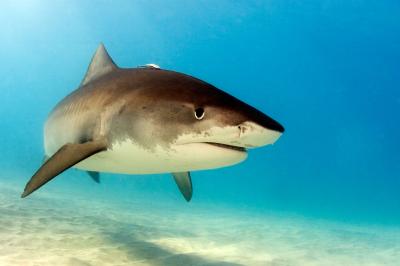

The tiger shark (Galeocerdo cuvier) is a wide-ranging apex predator distributed across temperate and tropical seas. Tiger sharks possess behavioral and anatomical specializations for hunting sea turtles. The top surface of the shark is darkly pigmented which also allows them to maintain camouflage when hunting turtles resting at the water surface. This study used long-term satellite tagging data from large tiger sharks and adult female loggerhead sea turtles (Caretta caretta) to examine their movements relative to one another and evaluate if turtles modify their behaviors to reduce their chances of shark attack. The results show that turtles do not alter surfacing behavior to risk avoidance but that sharks may modify their behavior in an effort to increase their chance to prey on surfacing turtles.
Credit: Neil Hammerschlag
A new collaborative study led by scientists at the University of Miami (UM) Rosenstiel School of Marine and Atmospheric Science & Abess Center for Ecosystem Science & Policy examined predator-prey interactions between tiger sharks and sea turtles off the northwestern Atlantic Ocean.
The research team used long-term satellite tagging data from large tiger sharks and adult female loggerhead sea turtles, common prey of tiger sharks, to examine their movement patterns and evaluate if turtles modify their behaviors to reduce their chances of a shark attack when turtle and shark home ranges overlapped.
The study revealed that tiger sharks undergo seasonal movements to take advantage of turtles nesting off the Carolinas during the summer. Tiger sharks are ambush predators, primarily attack surfacing turtles from below. In theory, loggerhead turtles should reduce their exposure at the surface in regions of high habitat overlap with tiger sharks. However, surprisingly, the researchers found that when shark-turtle overlap in the study region was high, turtles did not alter surfacing behavior to risk avoidance. Whereas, sharks did exhibit modified surfacing behavior believed to enhance predation opportunity.
“We suggest that sharks may not be an important factor influencing the movements of turtles in the study region,” said Research Assistant Professor Neil Hammerschlag at the UM Rosenstiel School & Abess Center. “In addition to the unpredictability of a shark attack over such a large area, it is possible that fishing of tiger sharks has reduced their populations to levels that no longer pose a significant threat to turtles, with other factors becoming more important such as the need to avoid boat strikes”
The study is one of the first to test if the “landscape of fear” model, a scientific theory that has been used to explain how animals move and interact with the environment based on their fear of being attacked by their predators, is applicable to large open marine systems involving wide-ranging species, like sharks and turtles.
“This is one of the first studies to compare the large scale, long-term movements of sea turtles with their natural predators, tiger sharks,” said study co-author Lucy Hawkes of the University of Exeter's Centre for Ecology and Conservation.
“These data are essential for setting and prioritizing marine protection for these species, which are both of conservation concern,” said study co-author Matthew Witt of the University of Exeter's Environment and Sustainability Unit.
###
The study, titled “Evaluating the landscape of fear between apex predatory sharks and mobile sea turtles across a large dynamic seascape,” was published in the July 23 online edition of the journal Ecology. The paper's co-authors include: Hammerschlag, Kyra Hartog, Emily Rose Nelson of the University of Miami; Annette C. Broderick, Brendan J. Godley, Matthew J. Witt and Lucy A. Hawkes of the University of Exeter; John W. Coker, DuBose B. Griffin, Sally R. Murphy, Thomas M. Murphy of the South Carolina Department of Natural Resources; Michael S. Coyne of SeaTurtle.org; Mark Dodd of the Georgia Department of Natural Resources; Michael G. Frick of the University of Florida's Archie Carr Center for Sea Turtle Research; Kristina L. Williams of the Savannah Science Museum's Caretta Research Project; and Matthew H. Godfrey of the North Carolina Wildlife Resources Commission.
The paper can be found here: http://www.
About the University of Miami's Rosenstiel School
The University of Miami is one of the largest private research institutions in the southeastern United States. The University's mission is to provide quality education, attract and retain outstanding students, support the faculty and their research, and build an endowment for University initiatives. Founded in the 1940's, the Rosenstiel School of Marine & Atmospheric Science has grown into one of the world's premier marine and atmospheric research institutions. Offering dynamic interdisciplinary academics, the Rosenstiel School is dedicated to helping communities to better understand the planet, participating in the establishment of environmental policies, and aiding in the improvement of society and quality of life. For more information, visit: http://www.












